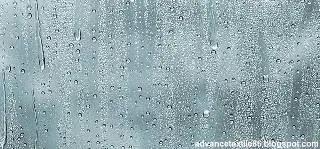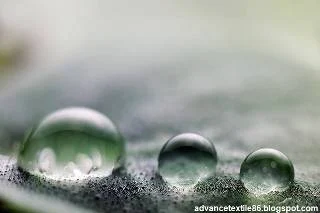Moisture management
Moisture
management can be defined as the controlled movement of water vapor and liquid
water (sweat) from the surface of the skin into the atmosphere through the
fabric. This action prevents sweating on the side of the skin. Moisture management
is one of the major performance criteria in today's garment industry, which
determines the comfort level of those fabrics. In order to maintain a
comfortable and cozy condition, clothing must be designed to maintain the
body’s thermal balance in a wide range of environmental conditions and body
activity. It should be met works without interfering with the evaporation of
moisture caused by sweat and thus does not interfere with the control of body
temperature. All of these desirable phenomena come under a technical scope,
called “moisture management”. "Breathability" means that air,
including water vapor, can pass through the fabric.
The
liquid water excreted by the body is known as sensory sweating. In order to
remove it from the body, it must pass through the fabric structure and then
evaporate from the outside of the fabric. When evaporated, heat is removed
which helps control body temperature. Water vapor or insensitive sweat can pass
through the opening between the fibers and yarn in a breathable fabric. When
water vapor is produced by the body, the heat is removed by providing a direct
cooling effect.
Objectives of moisture management for fabric
i.
To transport moisture to the atmosphere as quickly as possible - for
evaporation, the moisture must first reach the clothing page. It is caused by
capillary energy, also known as wicking. Capillary strength increases as the
gaps between the individual fibers become thinner. This means that the finer
the fibers, the smaller the gaps, and the better the moisture transport.
ii.
To evaporate moisture as quickly as possible-the evaporation of absorbed
moisture does not depend on the type of fiber, but rather on the surface of the
fabric used. The larger the surface, the finer the fiber, and the more fiber there
is on the surface, the faster the moisture evaporates.
iii.
To make the skin feel dry - It is unpleasant to wear clothes that have a moist
feeling. However, there is a difference between the materials in that the
amount of water from the layer makes the textile feel moist. Where cotton can
absorb a certain amount of water without feeling moisture, polyester feels wet
and clammy despite having a small amount of moisture. Moreover, coarse textiles
absorb more moisture than thin fabrics and their surface does not expand
significantly in the process. This is why it takes a long time to dry thick
clothes.
Technical application toward moisture management
100%
cellulose fiber clothing is widely used for general sports clothing and
streetwear, but the only fabric actively consumers and sportswear manufacturers
are made from synthetic fibers promoted for high-performance sportswear there
is a view that cellulosic fibers are unsuitable for use in sportswear for high activity where sweat production is required.
The
causes of this aspect of cellulosic fabrics are real and need to be addressed
if cellulosic is used in sportswear should be increased. Cellulosic fabrics absorb
water into the fiber structure and become heavier. This tension of the fabric
leads to sticking to the skin and when the activity stops the fabric can feel
cold against the skin.
A high level of moisture absorbed into the fabric means a long drying time.
However, cellulosic fabrics are usually synthetic fabrics that are considered more
comfortable when worn for normal daily activities. They are preferred for a
wide range of costume fabrics where visual aesthetics, handles, and comfort are
important. In this area, synthetic fiber where price and easy-care performance
are considered more important.
In
order to provide these positive properties of cellulose fibers and to overcome
the negative aspects of performance are needed new methods. A successful
cellulosic-containing fabric must have a much lower absorption capacity better
than 100% cellulosic but better than cellulosic fiber to give visual
aesthetics, handles, and touch. The fabric will have excellent moisture-handling ability and will be easy to care for. Can manage moisture includes the
use of microfiber technology or the application of various soft finishes such
as molecular silicon layers to improve both the hydrophobic and hydrophilic
properties of a fabric. Hydrophilic cloth or waterproof-breathable some
progress in the moisture management of textiles. Water-resistant and
moisture-permeable materials can be divided into three main categories -
high-density fabric, resin-coated materials, and film-coated. Items that
manufacturers select for casual, athletic, ski, or finished clothing need
outdoor clothing.
Moisture management indices
Moisture
management is assessed using a Moisture management tester (MMT). The device
measures the moisture on different sides of the fabric to get the moisture
transfer indicator. Wetting time (top/bottom), absorption rate (top/bottom),
maximum wet area (top/bottom), scattering speed (top/bottom), accumulated
one-way transport indicator, and overall moisture-management capacity (OMMC)
end of various garments Measurements are made to determine the suitability of
the fabric for use. The results are classified into six categories, namely
water-repellent fabric, slow-absorbing fabric, fast-absorbing, and slow-drying
fabric, fast-absorbing and quick-drying fabric, water-penetration fabric, and
moisture-management fabric.
The
results are reported based on the moisture-management index in the below chart
to determine the MMT grade of different fabrics. Overall moisture management
indicates how the fabric will work when applied to a specific situation.
Index Grade
1 2
3 4 5
Wetting
time Top ≥ 120 No
20–119 5–19 3–5
3
Wetting Slow
Medium Fast Very fast
Bottom ≥120 No 20–119
5–19 3–5 3
Wetting Slow Medium
Fast Very fast
Absorption
rate Top
0–10 Very 10–30 30–50 50–100 100
Slow Slow Medium Fast
Very fast
Bottom 0–10 Very 10–30 30–30
50–100 100
Slow Slow Medium Fast
Very fast
Maximum
wetted radius Top
0–7 No 7–12 12–17 17–22 22
Wetting Slow
Medium Large Very
large
Bottom 0–7
No 7–12 12–17 17–22 22
Wetting Slow
Medium Large Very
large
Spreading
speed Top 0–1 Very 1–2 2–3 3–4 4
Slow Slow Medium Fast Very
fast
Bottom 0–1
Very 1–2 2–3 3–4 4
Slow Slow Medium Fast Very fast
One-way transport capacity −50 − 50 to 100 100–200 200–400 400
Poor Fair Good Very good Excellent
Overall
moisture management 0–0.2 0.2–0.4 0.4–0.6 0.6–0.8 0.8
Poor Fair Good Very good
Excellent
Different concepts of moisture-management textiles
The term moisture management is often used as an advertising slogan.
However, ideas among textile manufacturers differ on how to achieve optimized
moisture management. To bring different effects, a suitable fiber material is
used or subsequent finishing is applied. It is also possible to combine
specialized fibers and finishes.
Hydrophobic
textiles absorb very little moisture. This can lead to insufficient
transmission of moisture away from the skin and an unpleasant damp feeling.
Moreover, the water that is not transported to the outer surface is no longer
available to cool the body.
i.
Hydrophilic textiles are known for their ability to absorb moisture. The
emerging fluid is efficiently absorbed and transported to the surface of the
skin for evaporation. However, after exercise, a large amount of fluid must
evaporate, which can cause strong cooling and freezing.
ii.
Combinations of internal hydrophobic and outer hydrophilic layers are designed
to quickly transport moisture from the skin and evaporate from the outside. The
material's special construction enables the transport of moisture from the
inside to the outside of the textile. Duble-sidedness of fabric is achieved
either by processing different materials during production or by the different
coating of the fabric surfaces.
iii.
Partial hydrophobic fabrics are made by an application for example by a
puncture technique of hydrophobic coating on the inside of the hydrophilic
fabric. The concept is that moisture can be transmitted through hydrophilic
“windows”, while hydrophobic regions do not absorb water and remain dry, giving
the skin a dry feeling.
iv.
By their extreme fineness, microfibers create particularly small gaps and have
a large surface area. This creates a high capillary effect for moisture
transport and rapid evaporation.
v.
Special fibers are designed to increase capillary strength and moisture
transport using special profiles. The larger surface area of these fibers
promotes evaporation.
Moisture management finishes of textiles
Moisture
management finishes improving the ability of textiles to absorb moisture from
the skin, transport them to the outer surface and release them into the
surrounding air. Similarly, moisture management finishes increasing the
moisture-holding capacity of the end fibers. The new generation of softening
agents that are part of the moisture management finish are able to greatly
improve the performance of the garment. This type of finish is usually applied
to towels, underwear, sports shirts, and other things where moisture absorption
is important. Manufacturers of sportswear are constantly striving to improve
the moisture management properties of clothing, so there is a lot of potential
for growth in this area.
Moisture
management fabric is widely applied in sportswear, high-value casual wear, and
uniforms. The concept of this technology is the rapid drying rate and the
efficient movement of moisture away from the skin. The process of moisture
management fabric can be divided into five states.
I.
Taking moisture from the surface of the skin.
ii.
Removing moisture away from the skin and transporting it through the fabric
surface.
iii.
Spreading moisture into the fabric structure.
iv.
Moisture absorption in suitable fibers: ‘Dynamic’ fabrics usually have an
‘outer layer’ of hydrophilic fibers that absorb and store sweat from the skin
surface.
v.
Moisture evaporates from the fabric surface.
Areas of application of moisture management technology
i.
Inner-wears
ii.
Athletic wear (active sportswear)
iii.
Performance wear (climbing, walking, skiing)
iv.
Comfort wear (nightwear)
v.
Military (multi-climate clothing)
vi.
Health (hospital bed linens, wound dressings)
vii.
Agricultural technology (Geo-textiles, greenhouse screening panels, soil
moisture control)
viii.
Technical solutions (Formula 1 protective clothing, firefighting, industrial
clothing)
ix.
Industrial (filter & valve technology, building, packaging)
x.
Upholstery (transport)
Conclusion
For comfort features of textiles with different end-use applications, in the general textile sector, technical textiles, and in other cases, moisture management plays a key role. Based on moisture management, tailors can be made for textiles with their specific end-use. Clothing manufacturers are changing them to pay attention to the high-efficiency end-use of moisture management cloth. As a sports manufacturer and active outdoor wear trying to improve their functionality collection will see further development of the field in the future moisture management fabric.











0 Comments